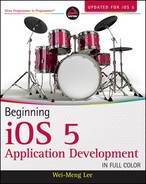CONTENTS
CHAPTER 1: GETTING STARTED WITH IOS 5 PROGRAMMING
Some Useful Information before You Get Started
CHAPTER 2: WRITING YOUR FIRST HELLO WORLD! APPLICATION
Customizing Your Application Icon
CHAPTER 3: UNDERSTANDING VIEWS, OUTLETS, AND ACTIONS
Adding Views Dynamically Using Code
CHAPTER 4: EXPLORING THE DIFFERENT VIEW CONTROLLERS
The Single View Application Template
Controlling Your UI Using View Controllers
The Empty Application Template
Adding a View Controller and Views Programmatically
Animating the Switching of Views
The Master-Detail Application Template
Displaying Some Items in the Master-Detail Application
The Tabbed Application Template
CHAPTER 5: ENABLING MULTI-PLATFORM SUPPORT FOR THE IPHONE AND IPAD
Technique 1 – Modifying the Device Target Setting
Detecting the Platform Programmatically
Technique 2 – Creating Universal Applications
CHAPTER 6: HANDLING KEYBOARD INPUTS
Customizing the Type of Inputs
Automatically Displaying the Keyboard When the View Window Is Loaded
Detecting the Presence of the Keyboard
Scrolling Views When the Keyboard Appears
CHAPTER 7: SUPPORTING SCREEN ROTATIONS
Responding to Device Rotations
Rotating to a Different Screen Orientation
Programmatically Rotating the Screen
Fixing the View Window to a Specific Orientation
CHAPTER 8: CREATING AND PERSISTING DATA USING THE TABLE VIEW
Modifying the Height of Each Row
Using the Table View in a Master-Detail Application
CHAPTER 9: USING APPLICATION PREFERENCES
Creating Application Preferences
Programmatically Accessing the Settings Values
Resetting the Preferences Settings Values
Understanding the Application Folders
Using the Documents and Library Folders
Storing Files in the Temporary Folder
Which Folder Should You Use: Documents or tmp?
Importing Self-Defined Documents
CHAPTER 11: DATABASE STORAGE USING SQLITE
Linking to the SQLite3 Library
Creating and Opening a Database
Examining the Database Created
Bundling SQLite Databases with Your Application
CHAPTER 12: PROGRAMMING ICLOUD
Storing and Using Documents in iCloud
Enabling iCloud Storage for Your Application
Managing iCloud Documents Using the UIDocument Class
Storing Key-Value Data in iCloud
CHAPTER 13: PERFORMING SIMPLE ANIMATIONS AND VIDEO PLAYBACK
CHAPTER 14: ACCESSING BUILT-IN APPLICATIONS
Accessing the Camera and the Photo Library
CHAPTER 15: ACCESSING THE SENSORS
Using the Gyroscope and Accelerometer
Using the Shake API to Detect Shakes
CHAPTER 16: USING WEB SERVICES
Basics of Consuming XML Web Services
Consuming a Web Service in Your iOS Application Using SOAP
Integrating Twitter into Your Application
CHAPTER 17: BLUETOOTH PROGRAMMING
CHAPTER 18: BONJOUR PROGRAMMING
CHAPTER 19: PROGRAMMING REMOTE NOTIFICATIONS USING APPLE PUSH NOTIFICATION SERVICES
Using Apple Push Notification Service
Generating a Certificate Request
Generating a Development Certificate
Configuring an App ID for Push Notifications
Creating a Provisioning Profile
Creating the Push Notification Provider
Displaying Maps and Monitoring Changes Using the Map Kit
Specifying the Hardware Requirement for Location Tracking
Displaying Location Using a Map
Getting Directional Information
Displaying a Disclosure Button
CHAPTER 21: PROGRAMMING BACKGROUND APPLICATIONS
Understanding Background Execution on the iOS
Examining the Different Application States
Detecting Multitasking Support
Tracking Locations in the Background
Making Your Location Apps More Energy Efficient
Notifying Other Objects Using the NSNotification Class
APPENDIX A: TESTING ON AN ACTUAL DEVICE
APPENDIX B: GETTING AROUND IN XCODE
APPENDIX C: CRASH COURSE IN OBJECTIVE-C
